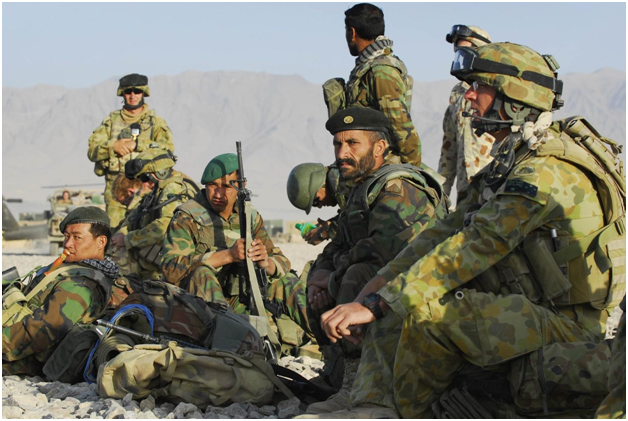Military Deaths Cross 2200 in Afghanistan
Vulnerable targets

NEW DELHI: As of August 2014, according to the Associated Press, at least, if not more, 2200 members of the United States military had died in Afghanistan, following the US-led invasion of Afghanistan since 2001.
Earlier this week, Sgt. 1st Class Matthew I. Leggett, of Ruskin, Fla., died as he was stabbed near the Kabul airport. A few days earlier, the NATO-led military coalition in Afghanistan announced the death of a servicemember from a “non-battle injury.”
According to AP figures, Leggett’s death is the 39th death this year of a US troop in Afghanistan and the ISAF servicemember is the 53rd such death this year for the coalition.
A month ago, General Greene, 55, died when an Afghan soldier opened fire on a NATO delegation, killing the General and injuring 15 others.
The AP figures corroborates with the US defence department numbers, which, tabulated till April 2014 records a total of 2,178 military casualties in Afghanistan till date, with 1,802 of these killed in action (KIA), and 373 in non-hostile circumstances. In addition to deaths, official reports state that the number of personnel wounded in hostile action is 19,698.
A survey by the Pew Research Centre for People and the Press, had concluded that for the first time, a majority of people in the United States view the war efforts in Afghanistan as a failure. 52 percent of the respondents said that the United States had “mostly failed” to achieve its objectives in Afghanistan compared to the 38 percent that felt it had “mostly succeeded.” A reason, in part, for declining public opinion in support of American military intervention in Afghanistan is the number of US military casualties in the region.
The cost of the war is staggering in terms of civilian Afghan casualties, with the UN Assistance Mission in Afghanistan (UNAMA), Annual Report on Protection of Civilians in Armed Conflict released earlier this year, pointing to a 14 percent increase in civilian casualties in 2013. a total of 8,615 civilian casualties with 2,959 civilian deaths and 5,656 injured last year. The figures mark a 7 per cent increase in deaths and a 17 per cent increase in injuries as compared to 2012. Since 2009, the armed conflict has claimed the lives of 14,064 Afghan civilians and injured thousands more, the report detailed.
The report also found that 2013 was the worst year for Afghan women, girls and boys since 2009 in terms of casualties resulting from conflict-related violence. There were 235 women killed and 511 injured, an increase of 36 per cent from 2012. UNAMA documented 561 children killed and 1,195 injured in 2013, an increase of 34 per cent compared to the previous year.
2014 is set to be worse, with 4853 civilian casualties between January 1 to June 30 according to UNAMA, up 24 per cent over the same period in 2013. “The nature of the conflict in Afghanistan is changing in 2014 with an escalation of ground engagements in civilian-populated areas,” said the UN Special Representative for the Secretary-General in Afghanistan and head of UNAMA, Ján Kubiš. “The impact on civilians, including the most vulnerable Afghans, is proving to be devastating.”
Included in the toll were 1,564 civilian deaths (up 17 per cent) and 3,289 injuries (up 28 per cent). Ground engagements caused two of every five civilian casualties in 2014 accounting for 39 per cent of all civilian casualties: 1,901 in total, up 89 per cent from 2013, with 474 civilians killed and 1,427 injured.
Total child civilian casualties increased 34 per cent in the first six months of 2014 to 1,071, including 295 killed and 776 injured, while total women civilian casualties increased 24 per cent to 440, including 148 killed and 292 injured. Ground engagements took the lives of 112 children and injured 408, with the total 520 child casualties, an increase of 111 per cent over 2013. Ground engagements killed 64 Afghan women and injured 192, with the total 256 women casualties, up 61 per cent over 2013.
“In 2014, the fight is increasingly taking place in communities, public places and near the homes of ordinary Afghans, with death and injury to women and children in a continued disturbing upward spiral,” said UNAMA’s Gagnon.
It is clear that the human cost of the Afghan war is high on both sides - for the US and for the people of Afghanistan. The question is: Is the end of the war in sight?



